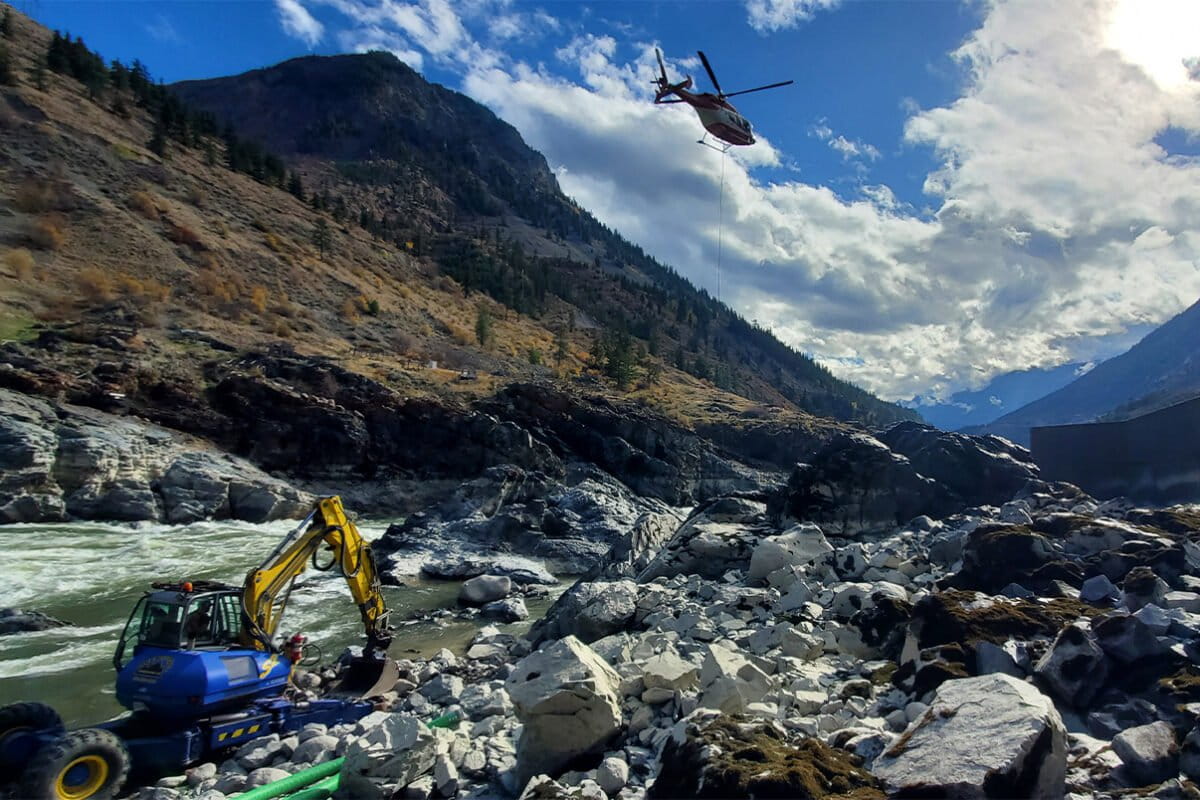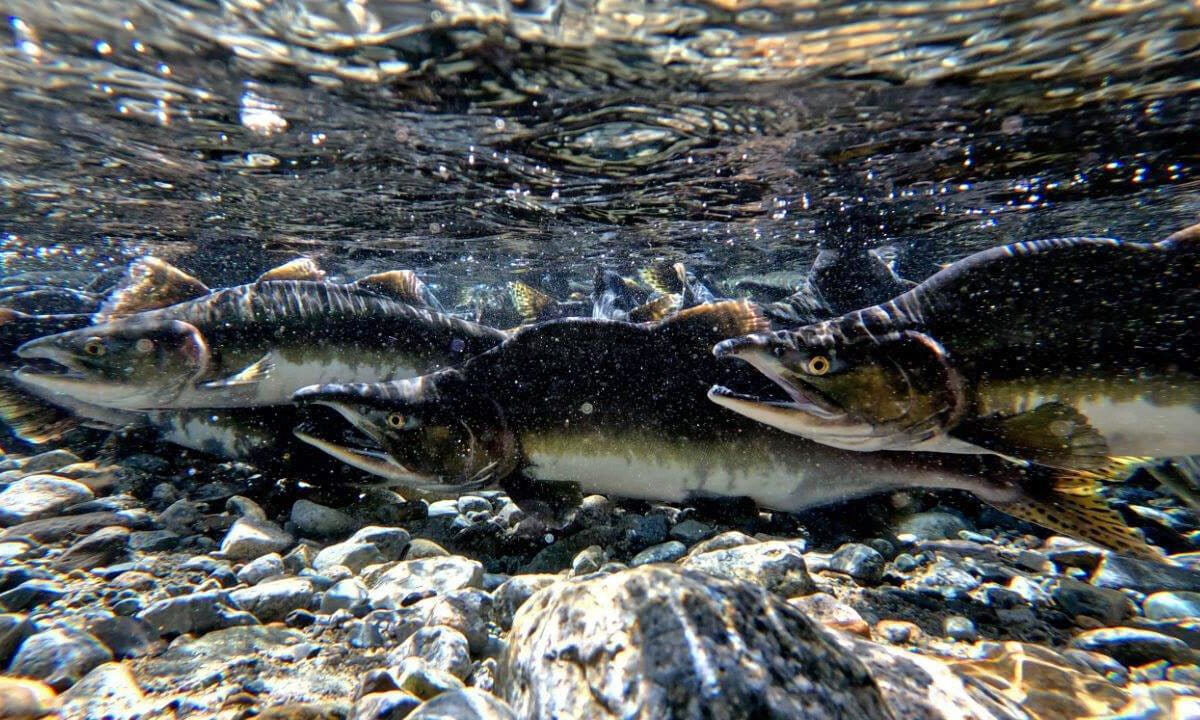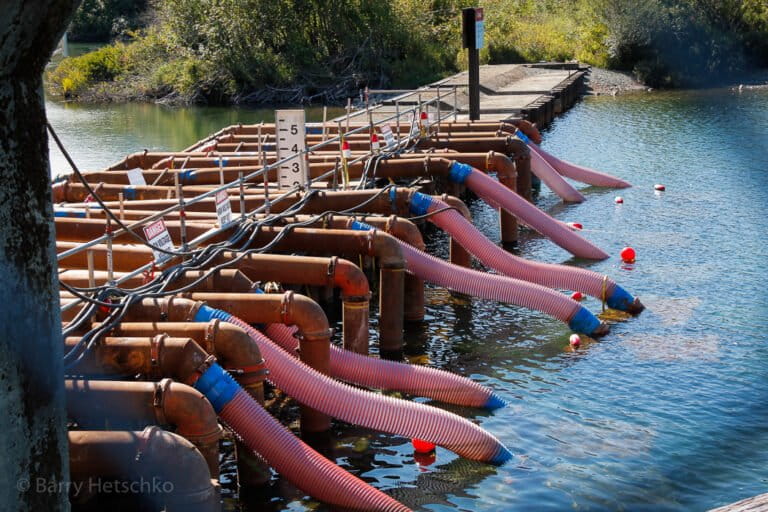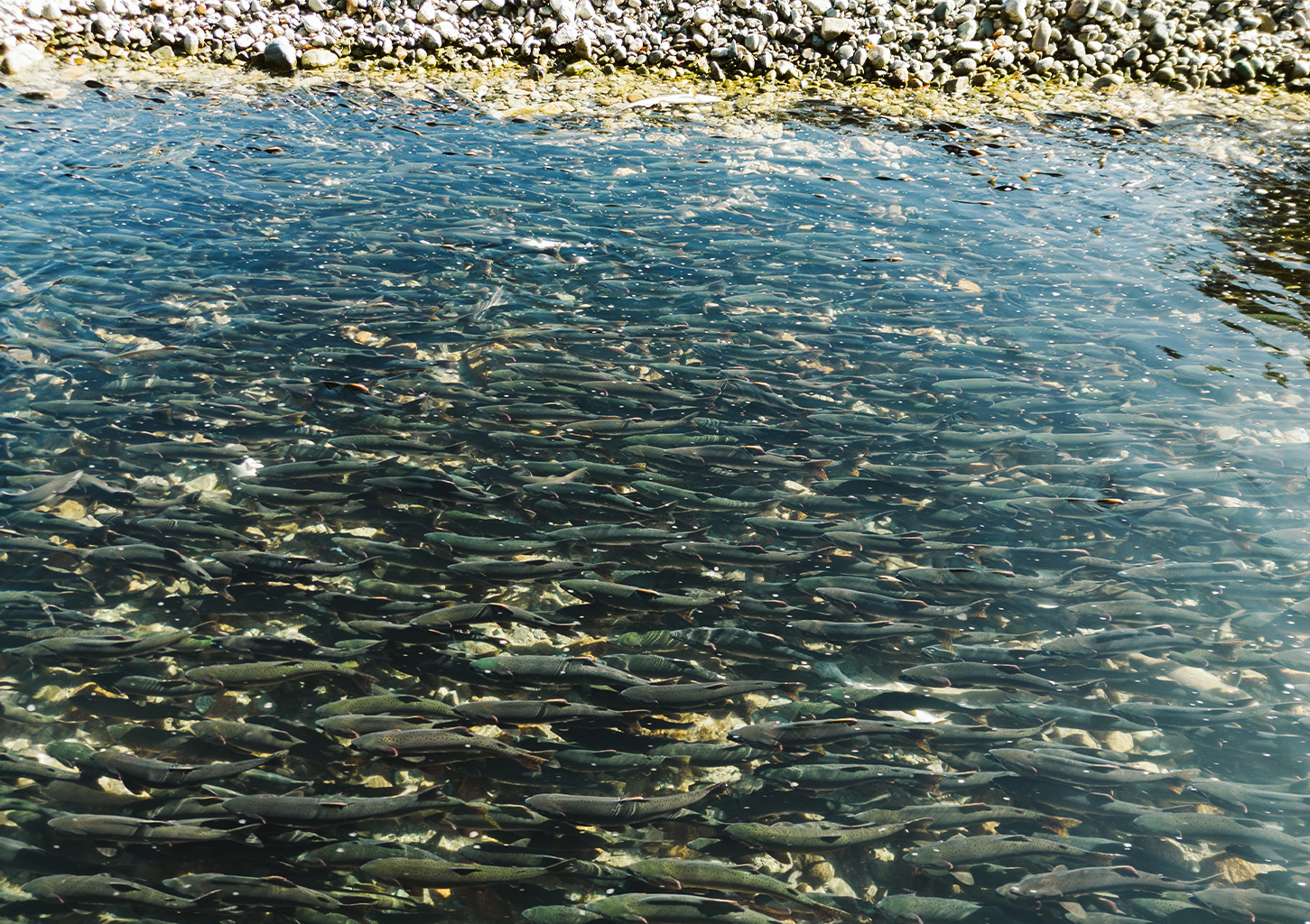- An unprecedented drought across much of British Columbia, Canada, and Washington and Oregon, U.S., during the summer and fall months of June through October could have dire impacts on Pacific salmon populations, biologists warn.
- Low water levels in streams and rivers combined with higher water temperatures can kill juvenile salmon and make it difficult for adults to swim upriver to their spawning grounds.
- Experts say relieving other pressures on Pacific salmon and restoring habitat are the best ways to build their resiliency to drought and other impacts of climate change.
One after another, salmon leapt out of the water and hurtled themselves at the falls, propelled by instinct to move upriver. They, like all Pacific salmon, were born in freshwater, migrated to the ocean and were now returning as adults to their natal streams to spawn and die. But the Fraser River was running low after months of drought. At this stretch near the Bridge River Rapids in southwestern British Columbia, Canada, the water was so low in mid-October that the salmon couldn’t access their usual passage up the fish ladder. Instead, they were desperately trying to find another way over the rocks, but they couldn’t make it.
For these fish, help was at hand. For days, members and friends of the Xwísten, an Indigenous group that is part of the St’át’imc Nation and whose territory encompasses this traditional fishing spot, scooped up salmon with large dip nets, passed them hand to hand in a human chain up the rocks, and released them above the falls. In all, they moved more than 7,000 fish. Eventually machinery was brought in; an all-terrain excavator chiseled out rocks to ease the salmon’s transit over the falls, and a helicopter dropped sandbags to raise the water level near the fish ladder.
“The project to save the fish is important to not only our community but to the St’at’imc Nation and many other Nations along the Fraser River,” says Xwísten Chief Ina Williams via text. “There are many animals, four-legged and winged, that also rely on the fish.”


Five species of Pacific salmon live in North America: chinook (Oncorhynchus tshawytscha), coho (O. kisutch), sockeye (O. nerka), chum (O. keta) and pink (O. gorbuscha) salmon. Their life cycles are similar, though the timing and duration of stages varies. Steelhead trout (O. mykiss) also move between freshwater and the ocean but don’t die after spawning. All species are adapted to cool, well-oxygenated water; temperatures above 17° Celsius (63° Fahrenheit) are stressful, and above 23°C (73°F) can be lethal.
But this year, across British Columbia (BC) and down into Washington and Oregon states in the U.S., cool water was in short supply. The winter snowpack melted early in an unseasonably warm spring, and scant summer rain left rivers low and streams dry. By August, 80% of BC water basins were at the two highest levels of drought, and all of Washington was under drought advisory. Summer 2022 was hot and dry, too, and climate modeling shows more is on the way.
About half of BC Pacific salmon populations are declining, and 28 populations in the U.S. Pacific Northwest are listed under the Endangered Species Act. That’s because dams block migrations, logging and other developments degrade spawning channels, hatchery fish erode genetic diversity, overfishing decreases abundance, and more. Now climate change is compounding existing pressures and adding urgency to recovery efforts.

Difficult decisions
The Cowichan Valley on Vancouver Island in southwestern BC is renowned for salmon and steelhead, which members of the Cowichan Tribes have fished since time immemorial. At the head of the valley sits Cowichan Lake. A meter-high (3-foot) weir built at the outflow in 1957 allows managers to store water from spring rains and release it into the Cowichan River during the drier summer months for communities, farms, a papermill and fish.
But Tom Rutherford, the Cowichan Watershed Board’s strategic priorities director, says in 15 of the last 20 years, it’s been so dry that doling out the water has entailed gut-wrenching decisions.
This spring, they had to cut the water flow to 60% of what’s normal, hoping it would be enough for the steelhead to lay eggs in the riverbed gravel, the newly emerged chinook fry to find refuge along the river’s edge and the year-old coho smolts to move downriver to the ocean.
But as summer progressed, temperatures rose and still the rain didn’t come. The river grew too low and hot. Along an 8-kilometer (5-mile) stretch, about one-fifth of the river, hundreds of salmon and trout died.
By early September, chinook were staging in Cowichan Bay, and early counts indicated a bumper run, 10,000-20,000 fish, Rutherford estimates. The watershed board switched on 20 industrial pumps in mid-September, to push enough water from the lake into the river so the chinook could move up to spawn, followed by coho. That brought the lake level down lower than it’s probably been in geological time, Rutherford says, and sucked water away from important shoreline habitat. For weeks, he was up early each morning, checking hydrographs and hoping the pumps wouldn’t fail.
“That’s what climate change looks like for us,” Rutherford says.

Drought is also impacting salmon recovery programs. The Simpcw First Nation’s Dunn Creek Fish Hatchery in southwestern BC has been raising coho for 40 years, and it’s had some success rebuilding the population. That’s of huge cultural importance, says Tina Donald, the hatchery manager. But, she says, because of low water levels, only 626 coho made it back to spawn in 2022, about one-tenth of what came the year before. This year, hatchery staff took preventive measures by digging sediment out from the creek’s mouth to improve flow — sediment that’s been washing down from the hillslopes since a large forest fire in 2017. And because Dunn Creek’s water has become too warm over the last decade to raise young fry, they’ve had to channel cooler water into the hatchery from a nearby creek and put in a well.
Although salmon are adaptable, Jason Hwang, vice president of salmon at the Pacific Salmon Foundation, a BC-based environmental nonprofit, says many biologists worry conditions like this year’s may be too far outside of normal. Species that spend a year or more in freshwater can be trapped in drying pools, and because the juveniles are small, that mortality may go unnoticed. For those that spawn far inland, lower and warmer water makes it like “swimming a marathon in a sauna,” Hwang says, and the stress makes them susceptible to disease or parasites.
“Their biology is really optimized to get into their home streams during certain periods of the year, because that’s the best time to lay the eggs, which ties to the best time for the juveniles to emerge, which gives them the best chance of survival,” Hwang says. “So the whole life history is potentially affected by things that are going to delay the salmon’s timing or affect the fitness of the adults that are spawning.”
Things aren’t any better in the ocean, where salmon gain most of their biomass. Marine heat waves like “the Blob” in 2013-15 can cause mass salmon deaths. Climate change is also altering ocean food webs, favoring some salmon species, like pink salmon, over others.

Restoring habitat
Experts say to counter the effects of drought on salmon, we need to restore a diversity of habitats and rebuild populations. The idea is to have more salmon, with a variety of life history strategies, in more places, so they are best able to respond to changing conditions.
In the mid-20th century, construction of large dams on the Columbia River in Washington state — the Grand Coulee in 1942 and the Chief Joseph in 1955 — prevented fish from reaching 40% of the watershed’s salmon and steelhead spawning habitat. The impact was devastating for Indigenous peoples in the U.S. and Canada.
“Salmon are the core of who we are as people,” says Jarred-Michael Erickson, Confederated Tribes of the Colville Reservation’s chairman. “I can’t tell you how much or how important that is to us.”
In September, long-standing efforts to bring those salmon back got a $200 million dollar boost when Confederated Tribes of the Colville Reservation, the Coeur d’Alene Tribe and the Spokane Tribe of Indians signed a funding agreement with the U.S. government to advance their plan to reintroduce salmon and steelhead into the Upper Columbia Basin.
With climate change, that’s more urgent than ever. “The higher you go up the Columbia [River], the cooler the water is, and so we’re trying to get them up into those headwaters where they actually have a chance,” Erikson says.
This funding comes alongside another $106 million for salmon recovery the Biden Administration announced in August, and the start of the largest dam removal project in U.S. history, to open 480 km (300 mi) of spawning habitat on the Upper Klamath River in California and Oregon.


Relieving fishing pressure
Predicting the long-term impact of a drought is tricky; the effects may not be clear for many years, until that year’s cohort returns to spawn. To make sure runs aren’t being overfished, Will Atlas, a biologist with the Oregon-based nonprofit Wild Salmon Center, says fisheries need to “keep their finger on the pulse,”so that they can respond to changing conditions like droughts.
Working with two First Nations in BC’s central coast, Atlas and other researchers developed a deep-learning method for analyzing video data to count returning salmon as they pass through weirs in the river. Their paper, published in September, demonstrates how the technique can improve in-season monitoring and management.
“We need to say OK, salmon are resilient. They still in many years will produce returns of fish that can support a harvestable abundance. But in some years, they won’t. And if we go into those years with blinders on pretending like the status quo is going to work that year, we run the risk of extirpating small populations or driving these populations down to a level that will no longer produce a sustainable abundance to harvest,” Atlas says.
For Hwang, events like this year’s drought underscore the need to make long-term changes.
“I think the takeaway is that we should really start thinking about revisiting how we manage water, how we manage our land use, how we manage our salmon habitat, how we manage our fishing and our fisheries, because we need to recognize that we’re likely to see difficult conditions along these lines [again].”
Banner image: Salmon attempt to make it up the falls at Bridge River Rapids on the Fraser River in southwestern British Columbia. Image by Brandon Deepwell.
To keep track of salmon migrations in real time, First Nations turn to AI
Citations:
Atlas, W. I., Ma, S., Chou, Y. C., Connors, K., Scurfield, D., Nam, B., … Liu, J. (2023). Wild salmon enumeration and monitoring using deep learning empowered detection and tracking. Frontiers in Marine Science, 10. doi:10.3389/fmars.2023.1200408
Cheung, W. W., & Frölicher, T. L. (2020). Marine heatwaves exacerbate climate change impacts for fisheries in the Northeast Pacific. Scientific Reports, 10(1). https://doi.org/10.1038/s41598-020-63650-z
Price, M. H., Moore, J. W., Connors, B. M., Wilson, K. L., & Reynolds, J. D. (2021). Portfolio simplification arising from a century of change in salmon population diversity and artificial production. Journal of Applied Ecology, 58(7), 1477-1486. https://doi.org/10.1111/1365-2664.13835
FEEDBACK: Use this form to send a message to the editor of this post. If you want to post a public comment, you can do that at the bottom of the page.
